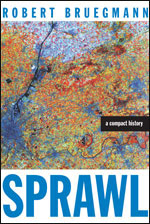
The Torontoist’s Ron Nurwisah sent this along to us:
Sprawl is the arch-nemesis of progressive urban planning. North America’s love affair with the car and the suburbs has created unsustainable, unlivable and homogenous neighbourhoods. Suburbs from California to Vancouver, from Miami to Toronto have led to gridlock, the destruction of green spaces and the collapse of once vibrant inner city areas.

Or have they? In the cheekily titled Sprawl: A Compact History, Chicago-based art history professor Robert Bruegmann argues that sprawl isn’t a 20th century North American phenomenon spurred on by cheap gas, highway construction and the automobile lobby, it’s actually been with us for much longer.
He argues that the desire of the wealthy for wide open spaces led to the development of “suburbs†in medieval towns, that cheap public transport led to a rapid expansion of London and other European cities in the 19th century and that the automobile and 20th century burbs are just a more recent version of this. In fact, sprawl, rather than being a negative, is actually a victory of economic egalitarianism as greater and greater numbers of people are able to afford something that was once only available to the very wealthy.
He’s got a few strong defenders. Well-known urban theorist and author Witold Rybczynski defended sprawl earlier last month on Slate.com and echoed Bruegmann’s arguments about sprawl being a natural part of cities. He also points out that European cities also have problems with sprawl, despite high gas prices and expensive real estate.
Equally interesting is a piece on Bruegmann in Governing magazine. Bruegmann isn’t some rabid defender of McMansions, gas-powered rider lawnmowers and toxic manicured lawns. He just sees the knee-jerk reaction against suburbs and sprawl as being unconstructive. It doesn’t help solve the very real problems that many cities are facing.

